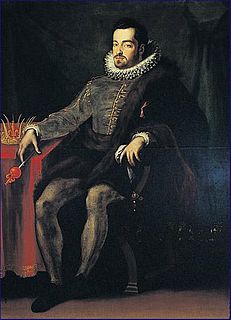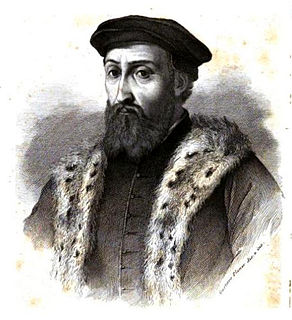
Pope Leo XI, born Alessandro Ottaviano de' Medici, was Pope from 1 to 27 April 1605. His pontificate is one of the briefest in history having lasted under a month. He was from the prominent House of Medici originating from Florence. Medici's mother opposed his entering the priesthood and sought to prevent it by having him given secular honours, but after her death he eventually was ordained a priest in 1567. In his career he served as Florence's ambassador to the pope, Bishop of Pistoia, Archbishop of Florence, papal legate to France, and as the cardinal Prefect for the Congregation of the Bishops and Religious. He was elected to the papacy in the March 1605 papal conclave and served as pope for 27 days.

Alessandro de' Medici called "il Moro" due to his dark complexion, Duke of Penne and also Duke of Florence, was ruler of Florence from 1531 to his death in 1537. The first Medici to rule Florence as a hereditary monarch, Alessandro was also the last Medici from the senior line of the family to lead the city. His assassination at the hands of a distant cousin, Lorenzaccio, caused the duchy of Florence to pass to Cosimo I de Medici, from the family's junior branch.
Tuscany is named after its pre-Roman inhabitants, the Etruscans. It was ruled by Rome for many centuries. In the Middle Ages, it saw many invasions, but in the Renaissance period it helped lead Europe back to civilization. Later, it settled down as a grand duchy. It was conquered by Napoleonic France in the late 18th century and became part of the Italian Republic in the 19th century.

Cosimo III de' Medici was the penultimate (sixth) Medici Grand Duke of Tuscany. He reigned from 1670 to 1723, and was the elder son of Grand Duke Ferdinando II. Cosimo's 53-year-long reign, the longest in Tuscan history, was marked by a series of ultra-reactionary laws which regulated prostitution and banned May celebrations. His reign also witnessed Tuscany's deterioration to previously unknown economic lows. He was succeeded by his elder surviving son, Gian Gastone, when he died, in 1723.

Ferdinando I de' Medici, Grand Duke of Tuscany was Grand Duke of Tuscany from 1587 to 1609, having succeeded his older brother Francesco I.

Luca Pitti (1398–1472) was a Florentine banker during the period of the republic presided over by Cosimo de' Medici. He was a loyal friend and servant to the Medici and the republic. He was awarded a knighthood, and received lavish presents from both the Signory of Firenze and the Medici family as a reward for helping maintain the government during the last years of Cosimo's rule when Cosimo was too old and feeble to maintain power alone.

Eleanor of Toledo (Italian: Eleonora di Toledo, born Doña Leonor Álvarez de Toledo y Osorio, was a Spanish noblewoman who was the wife of Cosimo I de' Medici and the Duchess of Florence. Although Eleanor is often referred to as the Grand Duchess of Tuscany, she predeceased the creation of the Grand Duchy of Tuscany. She is credited with being the first modern first lady, or consort. She served as regent of Florence during the absence of her spouse.

Vittoria della Rovere was Grand Duchess of Tuscany as the wife of Grand Duke Ferdinando II. She had four children with her husband, two of whom would survive infancy: the future Cosimo III, Tuscany's longest-reigning monarch, and Francesco Maria, a prince of the Church. At the death of her grandfather Francesco Maria della Rovere, she inherited the duchy of Urbino which reverted to her second son, Francesco Maria, at her death. She was later entrusted with the care of her three grandchildren. Her marriage brought a wealth of treasures to the House of Medici, which can today be seen in the Palazzo Pitti and the Uffizi Gallery in Florence.

Filippo Strozzi the Younger was a Florentine banker, and the most famous member of the Strozzi family in the Renaissance. He is best remembered as a tragic hero and defender of the lost Florentine republic against the Medici dukes – yet this is almost entirely a nineteenth-century fiction of nationalist historians and dramatists. He had been one of the staunchest supporters of the Medici in Florence and Rome.

The Order of Saint Stephen is a Roman Catholic Tuscan dynastic military order founded in 1561. The order was created by Cosimo I de' Medici, first Grand Duke of Tuscany. The last member of the Medici dynasty to be a leader of the order was Gian Gastone de Medici in 1737. The order was permanently abolished in 1859 by the annexation of Tuscany to the Kingdom of Sardinia. The former Kingdom of Italy and the current Italian Republic also did not recognize the order as a legal entity but tolerates it as a private body.

The Grand Ducal Crown of Tuscany was a ducal crown created by the Medicean Grand Dukes of Tuscany.

Bindo Altoviti (1491-1557) of the House of Altoviti was one of the most influential papal bankers of his generation and patron to the arts cultivating close friendships with artists as Vasari, Cellini, Raphael and Michelangelo
Antonio Altoviti was an Italian Catholic archbishop, son of Bindo Altoviti and archbishop of Florence from 1548 to 1573.













